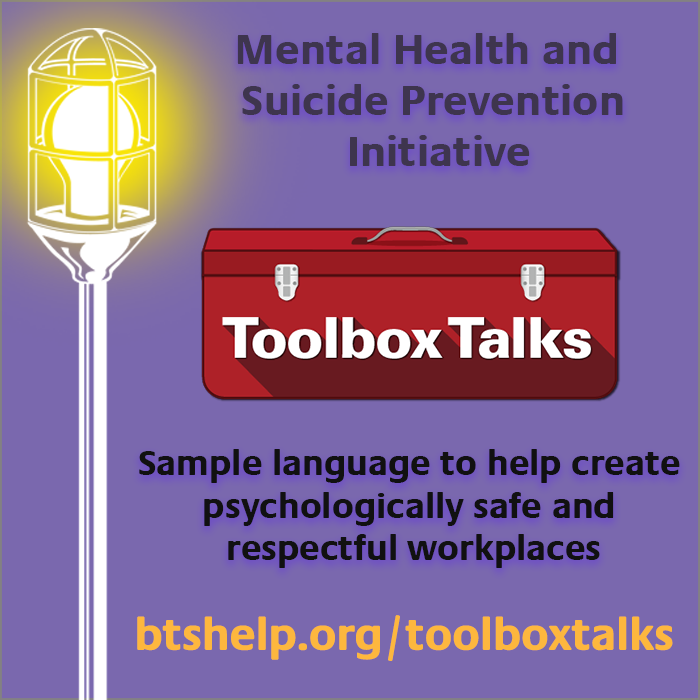
It is important to acknowledge the mental and physical stressors and challenges faced by all of us in the entertainment industry and offer your team tools to help them better manage and respond to these challenges. The Behind the Scenes Mental Health Initiative wants language about mental health and respectful workplaces to become a part of every toolbox talk or safety briefing because psychological safety is as important as physical safety. It’s not always an easy subject to talk about though, so to make it easier for those delivering these talks they are suggesting topics and providing sample language that can be used as is or tailored to fit individual needs.
BTS knows that the last many months in particular have been very stressful and returning to work is bringing a new set of concerns for everyone. Many people are struggling with anxiety, grief, feeling overwhelmed, inability to concentrate, changes in appetite or sleep, changes in drinking or substance use patterns, or other issues affecting daily functioning.
In addition to the sample language provided under each topic, they also offer a selection of brief pre-scripted talks. This information is meant to be incorporated into existing safety or toolbox talks and is not meant to replace other safety briefings.
For those needing to gain management approval to incorporate language about mental health into their talks, they offer some key reasons why it is important to talk about mental health and psychological safety in the workplace.
Why is it important to talk about mental health and psychological safety?
Good mental health improves productivity
Workers who are experiencing distress either from issues in the workplace or at home can be distracted to the point of creating a hazard. Having resources to deal with these stressors can help maintain a safer workplace and improve productivity.
Leaders talking about mental health de-stigmatizes it
Lead by example. If you talk about mental health without shame or fear of reprisal, they can too. By incorporating language about mental health into your toolbox talk, you are making clear that workers’ mental health and psychological safety are equal priorities. This conversation encourages workers to feel safe discussing mental health concerns in the workplace—a key part of a safe job site.
Discussing the organization’s commitment to mental health and wellness lets people know it is important to the organization
Communicating the organization’s commitment to creating a positive mental health work environment provides a sense of safety and encourages people to take their own mental health seriously, as well as to support their co-workers.
Offering anonymous ways of seeking support fosters the sense of security you are trying to create
No matter how supportive an organization is, people might still feel self-conscious about sharing personal issues or struggles in the workplace. Protecting confidentiality encourages people to speak up.
Encouraging feedback and suggestions to improve the mental health environment raises awareness and participation
Provide verbal, electronic, and written mechanisms for both anonymous or signed feedback and suggestions.
Put Together Your Toolbox Talk
Craft your Toolbox Talk by putting together statements from the subject areas that, the BTS Mental Health Initiative has on its website, that are important to you and your situation. You can click on each subject to find sample language that you can use as written or tailor to fit your needs. They’ve also provided downloadable Word documents to make it easier to cut and paste. They also have a series of pre-scripted 90-120 second Toolbox Talks if you would rather use that approach.
Behind the Scenes has collaborated with other concerned organizations and individuals to create the Mental Health and Suicide Prevention Initiative. A series of tools and resources has been developed to not only help you but also assist you in helping your colleagues, friends, and family.
Links to additional tools and resources and further information about the initiative.
Further information from Behind the Scenes’ on Toolbox Talks.
Off
More News
Support USITT
For many 501(c)3 nonprofit organizations, USITT included, donations are a lifeline. We are able to continue to expand our online offerings to our Members and to our industry thanks to Membership dollars and the generosity of our donors.







.avif)